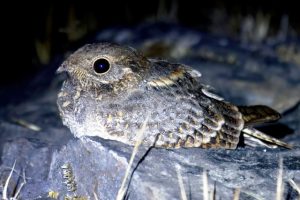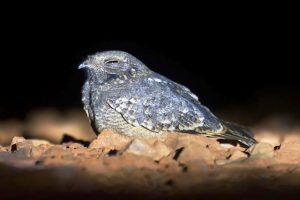Savanna Nightjar well-camouflaged nightbird, usually encountered roosting on gravel riverbeds, open areas in grasslands, rooftops, or roadsides. Sometimes found in small loose flocks when roosting. Fairly well adapted to urban life in some parts of its range and often found in towns and city edges. Intricately patterned gray-brown with less white than other nightjars; only males have a fairly small white patch on the wing near the tip. Most often detected by its distinctive, high-pitched, burry “chree-ik” song, repeated over and over.
The savanna nightjar (Caprimulgus affinis ) is a species of nightjar found in South and Southeast Asia. Eight subspecies are recognised: C. a. monticolus, C. a. amoyensis, C. a. stictomus, C. a. affinis, C. a. timorensis, C. a. griseatus, C. a. mindanensis and C. a. propinquus. Its habitat is open forest and areas with scrub. Its length is about 25 cm (9.8 in). The upperparts are brownish-grey and vermiculated, with pale brown speckles. The underparts are brown, with bars. The savanna nightjar is nocturnal and is recognizable by its characteristic loud chirping calls, mainly given in flight during the evening.
These nightjar species are distributed in India, Sri Lanka, Nepal, Bhutan, Bangladesh, China and Southeast Asian countries. The savanna nightjar species are nocturnal birds with long pointed wings, short legs and short bills. There are ten recognized subspecies of these nightjars.
The plumage of these species is cryptically colored to resemble bark or leaves. The overall plumage of these nightjar species is brown. The upperparts are brownish, having pale brown speckles and dark brown streaks and patches. The underparts are brown with bars.
The feet are short, of little use in walking. The gape is wide. The beak is short and has rictal bristles. The irises are dark brown. The wings are long and pointed. Their call is a loud, repetitive squeaky and often mechanical “kweek kweek” sound.
The savanna nightjar subspecies C. a. mindanensis is distributed in south-eastern Philippines. The subspecies C. a. monticolus is distributed in Pakistan, India, Nepal, Bhutan, Bangladesh, Myanmar, Thailand, Laos and Cambodia.
These savanna nightjar species have low forest dependency. These species occur in altitudes from 0 to 2000 meters approximately. These species inhabit artificial ecosystems like urban areas and open parks and roadside shrubs.
The natural ecosystem of these species includes subtropical and tropical mangrove vegetation, open woodlands, scrub jungle, temperate forests, deciduous forests, subtropical and tropical dry grasslands, shoreline, beaches, sand bars, subtropical and tropical savanna, savanna grasslands and grassy plains.
This was photographed at Sindhudurg, Maharashtra, India.
These camofludge beauties can be seen in Distribution: India, Pakistan, Nepal, Bhutan, Bangladesh, Myanmar, China, Taiwan (China), Thailand, Laos, Cambodia, Vietnam, Malaysia, Singapore, Indonesia, Philippines, Timor-Leste.
This was photographed at Lonavala, Maharashtra, India.

These rare photographs have been clicked and contributed by K. Shiva Kumar, a professional Wildlife Storyteller (M.A in Journalism & Mass Communication, an alumnus of Central University Of Odisha, Koraput) from Hyderabad, Telangana.



